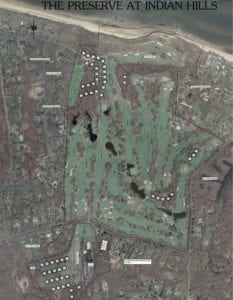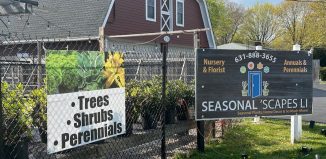
By Victoria Espinoza
Fort Salonga residents are waging battles on two fronts. One fight is to prevent the rezoning of the Indian Hills Country Club, and the other to ensure their civic association is fairly and accurately representing them.
Earlier this year, Jim Tsunis, of the real estate agency Northwind Group, applied to Huntington Town to change the zoning for the property from one-acre single family to open space cluster district. The proposal includes plans to build 108 townhomes and two cottages in several areas on the golf course. Northwind refers to the townhomes as houses for a 55 and over community, and said their plan will preserve 120 of the 143 acres at Indian Hills, won’t impact the views of the club from Breeze Hill Road and Fresh Pond Road, and will preserve the character of the neighborhood.
But residents are far from convinced. They fear the impact the development could have on the environment, traffic and safety during construction, and property value of the homes in the area.
Division within the Fort Salonga Association
Members of The Fort Salonga Association and Fort Salonga Property Owners Association expressed these concerns, however, FSA sent Huntington Town Supervisor Frank Petrone a letter approving the plan at the end of November.
Frank Capaccio, president of FSA, said in the letter that reaching the decision was difficult, but he explained that preserving the golf course is most important for residents.
“Our organization, for 70 years, has always been an advocate for what is best for the community at large,” Capaccio said in the letter. “While some feel the golf course should remain untouched and others feel 100-plus single family homes are a better alternative than townhouses, we disagree. The main purpose of establishing our organization was to preserve the quality of life and open space in our hamlet. Preserving the golf course does this.”
“We’re in a place we don’t want to be. We’re sort of fighting the FSA and we need to be fighting the developer. As we see it at the moment, there really is no difference.”
—John Hayes
The president acknowledged in the letter that the decision wasn’t unanimous among board members, and unknown decisions could still affect the plan.
“This was not an easy decision, and the ultimate configuration of development, including size, type, and quantity of homes, is yet to be determined,” Capaccio said.
Many residents are wondering why the association was compelled to make a decision so soon, before analysis was complete and a plan was finalized.
FSA director, William Berg said the board had initially planned to create a special committee to conduct an in-depth review of the plan’s environmental impact before any decision was reached.
“I volunteered … and [Capaccio] said he was going to contact other people, and then we never heard about a meeting or anything,” Berg said in an interview. “And then [25 days later], he emailed, saying it was time to have a vote.”
Berg said a fellow board member made a motion to delay the vote until the special committee was formed and able to share their findings, but it was declined, and the vote was carried out via email.
“One of the largest not only developments, but changes in zoning to occur in Fort Salonga’s history, there was no debate, there was no discussion,” Berg said.
According to Berg, 10 board members voted for it, two voted against, and one abstained. He said he doesn’t have the names of any of the members who voted for it. “It’s a secret,” Berg said.
At the last town board meeting, Petrone said the proposal was still in the early stages and the Huntington Zoning Board had not yet fully reviewed the plan to even schedule a public hearing.
“One of the largest not only developments, but changes in zoning to occur in Fort Salonga’s history, there was no debate, there was no discussion.”
—William Berg
John Hayes, president of the FSPOA and member of the FSA, said he doesn’t understand why a decision had to be made so quickly.
“It’s almost unprecedented for a civic association to go basically against the residents who clearly oppose it, at this stage of the game,” he said. “It is beyond any comprehension; we’re just scratching our heads. What’s the motivation here?”
Berg agreed the email vote was unusual.
“They can have email votes on minor issues, but when you have something like this, you normally would have a meeting and vote on it,” he said. “And it wouldn’t be done over a holiday weekend, in a rush.”
The FSPOA held a meeting a week earlier to explain the downzoning issue to their members, and Capaccio was present. Andrew Rapiejko, an FSA and FSPOA member who worked on the presentation, said it was announced at the end of the meeting that the FSA had posted a letter supporting the downzoning.
“There were gasps in the room,” Rapiejko said. He added it was also announced Capaccio was in the room, if he wanted to make a statement. Hayes said he declined, which they understood, since he was at the meeting as a private individual, but the president assured residents their questions would be answered at the Dec. 6 meeting.
Three days after the letter to Petrone from the FSA was posted on their website, the civic association announced they were cancelling the annual general meeting slated for Dec. 6.
In the letter, Capaccio explained the FSA voted to support the zoning change, but not the specific plan put forward by the club owner. He acknowledged the FSPOA’s disapproval of the plan, and the reason behind cancelling the meeting was an issue with three FSPOA members seeking positions on the board of the FSA.
“We determined that their initial independent nominations did not meet our requirements, which means their names would not have appeared on the ballot,” the president said. “In at least the last 40 years, this is the only time the FSA has had to prepare for a possibly contested election. While our by-laws allow for independent nominations and provide a process for a contested election, this is essentially a new process for us. As a result, the FSA board has decided we must postpone our annual meeting and election for 45 to 60 days so we can process an open and fair election.”
Rapiejko said this came as a shock to FSA members.
“These nomination petitions were sent in end of October, so they had them for a month,” he said. “All three candidates were sent certified letters saying that they were disqualified from the election. And the reasons given were confusing.”
“The rezoning does not compromise our one-acre zoning. The purpose of the cluster zoning law is to preserve open space.”
— Frank Capaccio
Rapiejko said members who hadn’t paid their annual dues made the nominations, thus the disqualification. Rapiejko was one of those members, according to the FSA, and when he reached out to correct them, that he had in fact paid his dues, they acknowledged the error, but the disqualifications stood.
“I got a response that said ‘Well, at that time of year we get a lot of checks and there was an error inputting your data that has been corrected’ and that was it,” he said. “No apology, no saying that we’re going to undisqualify the candidate. That was it.”
No new meeting has been posted to the FSA’s website as of publication, and the organization did not return request for comment.
“The rezoning does not compromise our one-acre zoning,” Capaccio said in the letter. “Any homes, cluster or single family, will not exceed the one-acre yield of the property. The purpose of the cluster zoning law is to preserve open space.”
He also stressed the FSA intends to continually represent the interests of the community at large.
“We have never been a single issue organization, representing only the few,” Capaccio said.
Rapiejko said the FSA and FSPOA have worked hand in hand on issues before, and he had hoped this time would be the same.
“It really worked very well,” he said of the partnership, recalling another zoning issue from 2003. “After that issue was over, the [FSPOA] was dissolved and we re-established spring of this year. We fully expected this to work the same way, to have that relationship. It wasn’t a competition.” He said the FSA does great work, and almost all of the FSPOA members are also members of the FSA.
Hayes said the current situation is far from ideal.
“We’re in a place we don’t want to be,” Hayes said. “We’re sort of fighting the FSA and we need to be fighting the developer. As we see it at the moment, there really is no difference. The only party that has benefited from their decision is the developer. It’s hard to split them at the moment. To say it’s unusual is an understatement, I think.”
Northwind didn’t respond to requests for comment.
Opposition to the rezoning of the golf course
Beyond the issues within the FSA, residents have major concerns with the impact rezoning could have on the Fort Salonga community.
“Once you concede to the change in zone, now you’re talking about negotiating where you’re putting the deck chairs on the Titanic.”
—John Hayes
Hayes said some support the rezoning but not necessarily the site plan.
“Once you concede to the change in zone, now you’re talking about negotiating where you’re putting the deck chairs on the Titanic,” Hayes said.
Rapiejko agreed the decision was a bit premature.
“For the FSA to pull out one piece of what this project is, and the downzoning is just one piece of the whole plan, and say ‘Well, this we believe is going to be good and is not going to have an impact,’ it’s just irrational,” he said. “It’s not logical, and that’s why you never want to do it. You always want to look at the whole plan to make a decision on the whole plan and the impacts of the whole plan.”
The proposed plan from Northwind calls for two areas of 46 town homes on the golf course, one area with 16 town homes, and two cottages. According to Hayes, the plan would also call for the use of a narrow private road in Fort Salonga as access for residents of Northwind. According to the company’s website, the plan will preserve 120 of the 143 acres of land at Indian Hills.
Rapiejko has worked in the Suffolk County Health Department for close to 30 years, where he has gained experience in dealing with environmental issues, and he said the title of the new project is insulting to people’s intelligence.
“He’s changed the name to The Preserve at Indian Hills, and he’s billing this as a preservation effort,” Rapiejko. “When I look at this golf course, I don’t see a preserve. What I see is a developed piece of property. When I look at this proposal, I’m seeing it as a tremendous increase in development.”
Rapiejko is worried about nitrogen pollution in drinking water.
“He’s changed the name to The Preserve at Indian Hills, and he’s billing this as a preservation effort. When I look at this golf course, I don’t see a preserve. What I see is a developed piece of property.”
—Andrew Rapiejko
“Nitrogen in our area is a huge, huge issue,” Rapiejko said. “And I see a very intense nitrogen use here.” He said the golf course is basically a peninsula surrounded by the Crab Meadow Watershed, the Long Island Sound and the Fresh Pond — and each would be sensitive to nitrogen and pesticides.
Rapiejko said the Suffolk County Health Department has been conducting a study on golf courses. A monitoring well for the Indian Hills Country Club found the current nitrate levels are more than five parts per million.
“That is prior to 32,000 gallons per day of sewage that he is going to be discharging as a result of his development, and discharging on site,” Rapiejko said. He added the plan calls for septic systems for each of the clusters, which will be recharged on site close to the water bodies. That could add more nitrogen to the waterways, as well as other things discharged from septic systems, like pharmaceuticals and personal hygiene products.
In the environmental proposal, nitrogen and phosphorus levels were tested at Fresh Pond in May and August — where most of the water from the area is discharged. Total nitrogen levels were 6.03 milligrams per liter, and 1.75 milligrams per liter for phosphorus. Rapiejko compared the numbers with Environmental Protection Agency water quality criteria recommendations, which recommend surface water nitrogen levels at 0.32 milligrams per liter and phosphorus levels at 0.008 milligrams per liter.
‘It’s kind of curious, because you do an environmental impact statement to asses the impact of what you’re proposing to do and to see if it’s significant,” Rapiejko said. “In this case, it’s obvious that there is already a significant impact with what is already here that needs to be addressed, no less worrying about impacts of a proposed development.”
Rapiejko said storm water runoff could also significantly impact the water quality at Fresh Pond.
Residents are also worried about the septic systems.
In this case, it’s obvious that there is already a significant impact with what is already here that needs to be addressed, no less worrying about impacts of a proposed development.”
—Andrew Rapiejko
According to the proposal, “each of these subzones will utilize a tertiary treatment system that is recognized by SCDHS, or one that may be approved as a pilot installation through SCDHS Board of Review approval.”
Rapiejko said this means the builder plans on using one of the new, innovative septic systems the county has been researching, which have not yet been approved and would require a variance from the town to use. The builder proposed The Preserve be used as a test site for one of the new systems.
“We don’t even know if these systems work or not,” he said.
Rapiejko compared this project to a similar development in Southampton — The Hills — which used the same engineer group as The Preserve. That project, if approved, would entail a golf course with more than 100 townhouses on the property, and Rapiejko said when he looked at the environmental proposal for that project, it came with seven alternatives.
The Preserve currently has two alternatives, one is no action, and the other is single-family, one-acre homes across the entire golf course, which would require eliminating the ponds and building on steep hills and slopes.
“Here he gave us one non-reasonable alternative,” Rapiejko said.
The plan calls for work from 7 a.m. to 6 p.m. Mondays through Fridays, with 32.75 acres needing to be cleared. Residents cite increased traffic and possible safety problems for bikers and walkers as other concerns.
According to the proposal, the average selling price per unit is about $800,000, which would total more than $85 million if all units were sold. The property was sold for $13.5 million.
A petition condemning the rezoning, with more than 400 signatures of Fort Salonga residents, is circulating.
The Huntington Zoning Board hasn’t reached a decision, which is the next step in the process.






